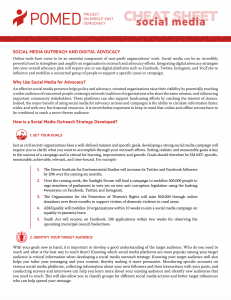Online tools have come to be an essential component of non-profit organizations’ work. Social media can be an incredibly powerful tool to strengthen and amplify an organization’s outreach and advocacy efforts. Integrating digital advocacy strategies into your overall advocacy plan will require you to use digital platforms such as Facebook, Twitter, Instagram, and YouTube to influence and mobilize a concerned group of people to support a specific cause or campaign.
WHY USE SOCIAL MEDIA FOR ADVOCACY?
An effective social media presence helps policy and advocacy-oriented organizations raise their visibility by potentially reaching a wider audience of concerned people, creating a network/coalition of organizations who share the same mission, and influencing important community stakeholders. These platforms can also support fundraising efforts by catching the interest of donors. Indeed, the major benefit of using social media for advocacy actions and campaigns is the ability to circulate information faster, wider, and with very few financial resources. It is nevertheless important to keep in mind that online and offline actions have to be combined to reach a more diverse audience.
HOW IS A SOCIAL MEDIA OUTREACH STRATEGY DEVELOPED?
1. Set Your Goals
Just as civil society organizations have a well-defined mission and specific goals, developing a strong social media campaign will require you to clarify what you want to accomplish through your outreach efforts. Setting realistic and measurable goals is key to the success of a campaign and is critical for learning, improvement, and growth. Goals should therefore be SMART: specific, measurable, achievable, relevant, and time-bound. For example:
- The Green Institute for Environmental Studies will increase its Twitter and Facebook followers by 20% over the coming six months.
- Over the coming week, the Sunlight Forum will lead a campaign to mobilize 500,000 people to urge members of parliament to vote yes on new anti-corruption legislation using the hashtag #weseeyou on Facebook, Twitter, and Instagram.
- The Organization for the Protection of Women’s Rights will raise $50,000 through online donations over three months to support victims of domestic violence in rural areas.
- All4Equality will mobilize 10 organizations within 10 weeks to join a social media campaign on equality in paternity leave.
- Youth Act will receive, on Facebook, 100 applications within two weeks for observing the upcoming municipal council byelections.
2. Identify Your Target Audience
With your goals now in hand, it is important to develop a good understanding of the target audience. Who do you need to reach and what is the best way to reach them? Knowing which social media platforms are most popular among your target audience is critical information when developing a social media outreach strategy. Knowing your target audience well also helps you tailor your messaging and your content, thereby making it more persuasive. Monitoring specific accounts on various social media platforms, collecting information about your own followers and their interactions with your posts, and conducting surveys and interviews can help you learn more about your existing audience and identify new audiences that you need to reach. This will also allow you to classify groups for different social media actions and better target influencers who can help spread your message.
3. Identify the Most Suitable Social Media Platforms for Your Organization and Your Needs
Based on your target audience and organizational needs, identify the platforms that are best to help achieve your goals. Every social media platform has a different function and purpose, and appeals to different demographics. Begin by selecting a primary platform for your digital advocacy and commit to it. After becoming comfortable with that platform, consider expanding to others—if doing so makes strategic sense.
An increase in the number of your social media platforms does not necessarily mean an increase in your reach, so be realistic about your ability to engage on different platforms. Before creating dozens of new accounts, ask yourself: Do we have the time and resources to manage these accounts, and will we have enough quality content to post on them? On which platform(s) is/ are our current largest audience(s)? Would creating an account on a new platform make us more likely to reach our target audience(s), or are we already on the platform(s) they’re most likely to use? What do we need to achieve and how can we best achieve it?
4. Create Compelling, Creative, and Original Content
Don’t post for the sake of posting. The content you develop needs to attract the attention of your target audience. The consistency of your social media presence is important, but the quality of the content is essential. Put effort into designing creative, original, and interactive content that can draw out an audience’s curiosity and build an identity that will make you and your work more recognizable across accounts and campaigns. It is also important to determine the “voice” that your posts will have. Will you use a formal tone, or one that is more casual? The tone used in social outreach can either underscore or undercut your message. For example, if you want to make a complex issue more approachable, you will want to use a more casual and perhaps humorous or friendly tone. Meanwhile, if you are trying to draw attention to a serious and urgent issue, you may opt to use a more serious tone that reflects the urgency of the matter. Focus on storytelling and posts that have concise but informative text and use graphics, photos, or videos to attract attention. Use your social media account(s) to promote your events. Create a hashtag or use an existing one to increase a post’s reach. Make sure that your message is coherent and “easily digestible”—each post is a fleeting opportunity to stand out from the crowd and “hook” your audience.
5. Consider Timing
Timing is important for carrying out a specific task on your social media account. You have to consider when your audience is most likely to be on social media in order to maximize the number of people who see your updates. Good hours to post are generally between 8:00am and 3:00 pm.[1] You may want to avoid the lowest engagement hours, typically before 6:00am and after 7:00pm, though it’s important to note that these hours will differ across cultures and countries. (Another reason it’s important to know your audience!) In addition, to maximize the visibility of your content, research[2] suggests that ideal posting frequency is as follows:

However, even ideal posting frequency can differ across cultures and countries and must be adjusted according to your knowledge of the target audience.
6. Measure Your Efforts
Measuring your social media efforts helps you evaluate your performance and learn the types of content that successfully engage your audience. Use these metrics to determine what needs improvement. To do this, make use of social media analytic tools to measure the outcomes of your strategy. Many social media platforms offer free built-in analytics[3] through which you can track data and Google Analytics provides information on websites.
For example, if community engagement is your goal, you might measure success by responses to your posts, number of shares, and engagement in social discussions through comments. Or, if you want to mobilize the public to take action, you can measure the impact by the number of shares, event attendance, or the number of times a hashtag was used, depending on the type of action you want your audience to take.
A good measurement to use if you have a fundraising goal is the conversion rate. For instance, you ran a social media campaign that brought 100 visitors to a donation page where they had to complete and submit a form. If 20 of the 100 visitors actually completed and submitted the form and made a donation, your campaign has a 20% conversion rate. You can use this measurement as a data point, which can be compared against other, similar campaigns to gauge a campaign’s success.
Although “likes” and “follows” are important social media metrics, remember that the ultimate goal is audience engagement. Engaging your followers is essential. By encouraging them to interact with your social media, you help build their affinity for your organization and, thus increasing your exposure. Make your followers part of your work and take time to respond to their comments with an authentic and positive tone of voice. Be prepared for people who may disagree with your position, give negative feedback, or say negative things. If a reply is required, respond with a simple statement recognizing their input, but backing up your claim. Don’t ignore or delete the comment—unless it’s deliberately offensive, inappropriate, or inflammatory— because even negative comments help increase your reach.
NOTES
1. https://sproutsocial.com/insights/best-times-to-post-on-social-media/
2. https://sproutsocial.com/insights/social-media-calendar/
3. Facebook provides social media analysis through the Facebook Insights tool. It allows the administrator of the page to track on a daily basis data about interactions with the page, the number of views, and the performance of posts and their reach.




